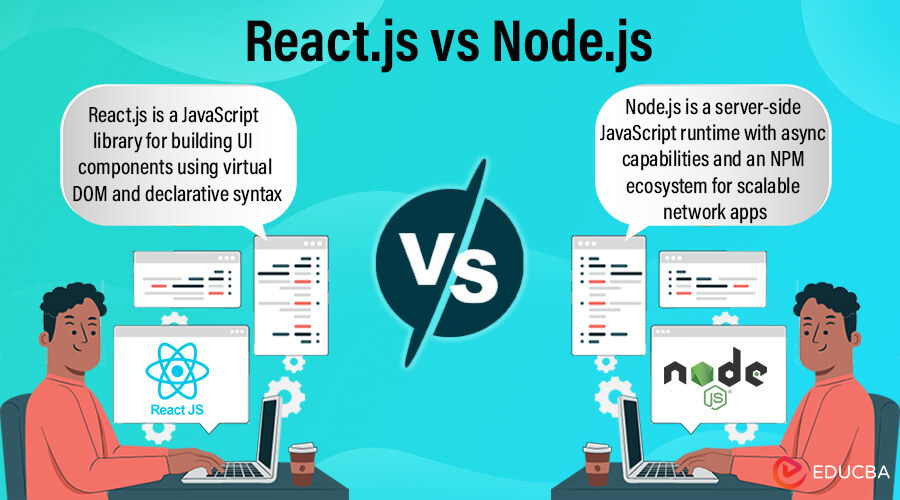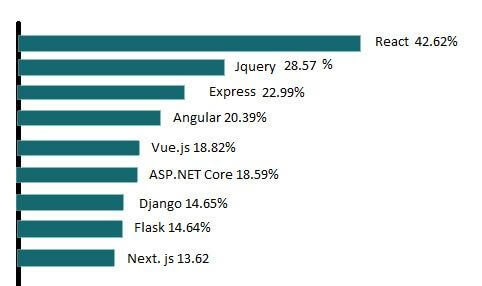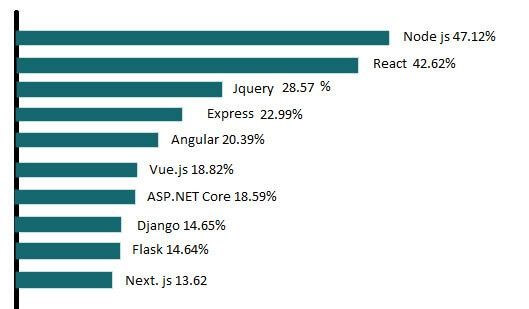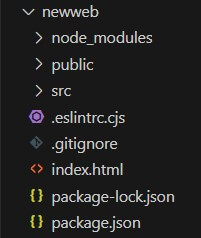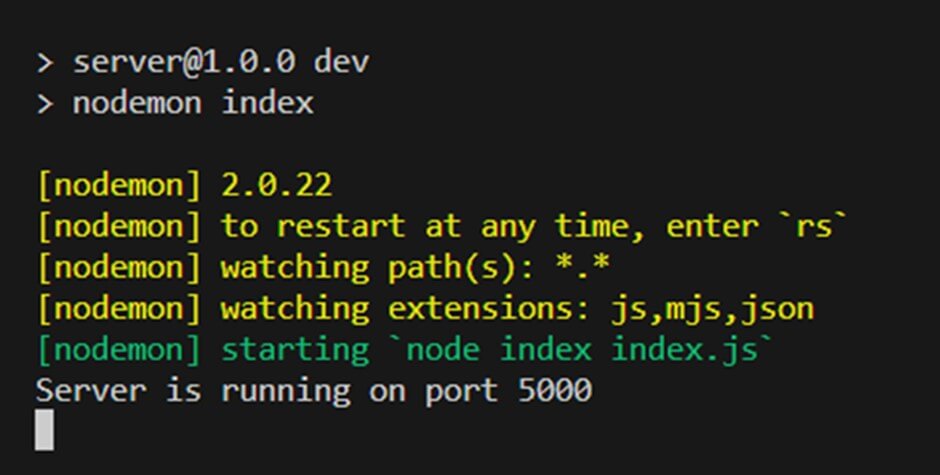Difference Between React.js vs Node.js
In the dynamic programming world, react.js and node.js are two powerful JavaScript libraries that play distinct roles in shaping modern web development. React.js is ranked as the most popular JavaScript framework for developing interactive user interfaces, and node.js is reported as the most used server-side programming framework. Let’s explore these two pivotal technologies and how developers navigate the intricate development ecosystem where react.js provides a highly performant experience, and node.js offers a scalable environment with optimal performance.
Table of Contents
- Difference Between React.js vs Node.js
- What is React.js
- What is Node.js
- Comparison Table React.js vs Node.js
- Uses Statistics and popularity Worldwide
- React.js vs Node.js Integration
- Node js vs React js: Which is Better?
Key Takeaways
- js and Node.js applications, features, advantages, and disadvantages.
- React’s immense strengths in UI development.
- js enhanced capabilities in handling server-side programming, event management, and asynchronous models.
- Comparison based on its use cases, popularity, community, and library support.
- js and React.js integration to form a full-stack scalable and responsive application.
What is React.js
React.js was developed by Facebook in 2011. React is a platform-independent JavaScript library that lets us build dynamic and interactive user interfaces with isolated pieces of components that can be combined into an entire complex application. React is a server-side programming language with performant development experience.
-Using of React.js
Many giant organizations worldwide have used React as their primary platform to build an interactive user interface. Let us look at some of them:
1) Netflix: Netflix stated that React has crossed their requirements and built a powerful application with extraordinary features and quick response time.
2) Facebook: The developer has used React.js to build one of the most widely used social networking websites. The Interactive segment of React.js makes it easy for users to develop pages with multiple functionalities.
3) Airbnb: Airbnb opted for react.js to maintain the quality of code with reusable components. It helped to develop responsive pages with quick response time.
4) Reddit: In 2016, Reddit announced its first usage of React in its application. Reddit also executed React-based programming to create its mobile-based application. React and Redux helped Reddit make reusable components, which helped maintain good coding practices.
5) BBC: To give users their best experience, BBC adapted React.js so that their users can choose the content with React.js interactive and dynamic pages.
-Features of React.js
JavaScript XML: JSX is a syntax extension used for writing JavaScript objects within HTML elements to describe application appearance, enhancing programming and readability.
Virtual Dom: Virtual DOM (Document Object Model) represents the real DOM that re-renders the entire User Interface whenever a modification occurs in an application and updates only the changed part in real DOM, optimizing the rendering process and reducing browser workload.
Components: Reacs.js lets us write several components with their unique logic and design to represent the User interface structure, these components are reusable and allow developers to work smoothly on larger application
One-way Data Binding: React.js follows a one-directional data flow, meaning data flows from parent components to child components. Child components use props to communicate with parent components and employ callback features to modify components. One-directional data flow improves coding efficiency and simplifies state management.
Conditional Rendering: React enables rendering components conditionally, and the User Interface displays data based on JSX conditions.
Example:
React.js allows us to create components in two different ways that are functional components and class components, allowing developers to choose according to their specific requirements and flexibility. Let us see how to create a straightforward form with two fields for input and a submit button in both these primary ways:
Class Component:
import React, { Component } from "react";
class SimpleForm extends Component {
render() {
return (
<form
style={{
width: "300px",
backgroundColor: "#f5f5f5",
padding: "20px",
border: "1px solid #ccc",
margin: "0 auto",
}}
>
<h2 style={{ textAlign: "center", marginBottom: "22px" }}>
My Testing Form
</h2>
<div style={{ marginBottom: "10px" }}>
<label htmlFor="name">My Name:</label>
<input
type="text"
id="name"
placeholder="Enter your First name"
style={{
padding: "12px",
width: "100%",
boxSizing: "border-box",
borderRadius: "4px",
border: "1px solid #ccc",
}}
/>
</div>
<div style={{ marginBottom: "10px" }}>
<label htmlFor="email">My Email:</label>
<input
type="email"
id="email"
placeholder="Enter your primary email"
style={{
padding: "12px",
width: "100%",
boxSizing: "border-box",
borderRadius: "4px",
border: "1px solid #ccc",
}}
/>
</div>
<button
type="submit"
style={{
backgroundColor: "blue",
border: "none",
color: "#fff",
borderRadius: "4px",
cursor: "pointer",
padding: "11px 22px",
}}
>
Submit Form
</button>
</form>
);
}
}
export default SimpleForm;Explanation of crucial steps
- Initially import class components for creating class-based components from React.
- Declare a SimpleForm class that extends the Component class from React to handle state and lifecycle methods.
- The Render Method specifies which components will appear on the screen. It will return the JSX element, which displays the structure of the form.
- The form element creates the complete form structure featuring two name and email input fields and a submit button.
- Form elements receive inline styling to define the form’s look and feel.
Output:
Functional Component:
import React, { useState } from "react";
const SimpleForm = () => {
const [email, setEmail] = useState("");
const [name, setName] = useState("");
const handleSubmit = (e) => {
e.preventDefault();
console.log("Name:", name);
console.log("Email:", email);
};
return (
<form
onSubmit={handleSubmit}
style={{
width: "300px",
margin: "0 auto",
backgroundColor: "#f5f5f5",
border: "1px solid #ccc",
padding: "22px",
}}
>
<h2 style={{ textAlign: "center", marginBottom: "22px" }}>
Educba Form{" "}
</h2>
<div style={{ marginBottom: "10px" }}>
<label htmlFor="name">Name:</label>
<input
type="text"
id="name"
value={name}
onChange={(e) => setName(e.target.value)}
placeholder="Enter your First name"
style={{
padding: "12px",
width: "100%",
boxSizing: "border-box",
borderRadius: "4px",
border: "1px solid #ccc",
}}
/>
</div>
<div style={{ marginBottom: "10px" }}>
<label htmlFor="email">Email:</label>
<input
type="email"
id="email"
value={email}
onChange={(e) => setEmail(e.target.value)}
placeholder="Enter your primary email"
style={{
border: "1px solid #ccc",
padding: "12px",
width: "100%",
boxSizing: "border-box",
borderRadius: "4px",
}}
/>
</div>
<button
type="submit"
style={{
padding: "10px 20px",
cursor: "pointer",
border: "none",
backgroundColor: "blue",
color: "#fff",
borderRadius: "4px",
}}
>
Submit Form
</button>
</form>
);
};
export default SimpleForm;Explanation of crucial steps
- Import useState hook for the functional component to manage state.
- Declare a SimpleForm functional component with constant and arrow function
- Create a state variable for name and email with empty string and update function
- Handle form submission with the event handler to prevent default submission and log state value in the console
- The form element creates the complete form structure, a submit button, and two name and email input fields.
- onSubmit event handle form submission and onChange event update state value
Output:
Use Cases
1. Single Page Application: React has a valuable use for developing single-page applications that allow fast rendering. An entire application runs on a single page with a complex user interface.
Example:
Travel booking sites for booking details and map search
Banking for updated bank details and transactions.
2. Dynamic Applications: React builds interactive web applications with component-based architecture. These dynamic websites display updated content for interactive user interfaces.
Example:
Customer Live chat support with instant message service
E-commerce website with quickly loading new updates
News application for dynamic updates and personalized content.
3. App Development: React frameworks are used to create cross-platform applications, which save development time and cost
Example:
Progressive web app with offline capabilities and push notification
Native mobile application for iOS and Android
Dynamic language processing virtual assistance
4. Form validation: React makes form validation easier with an events handler for handling form events, a state to manage and update input, and form libraries for validation.
Example:
Log in and sign up form with account credentials.
Contact form for a website with personal details and validate fields
Legal form with sensitive data
5. SEO-friendly website: With server-side rendering, react makes content-heavy websites load faster, which ranks them higher in search results, improves performance, and drives more traffic.
Example:
Lazy loading, which minimizes loading time and improves page size
Responsive page, which adapts to different screen sizes
Structured content with HTML elements for an interactive page feel
6. Dashboard and Data Visualization tools: React creates data visualization tools and dashboards with real-time rendering as data changes dynamically. Combining D3.js with React allows for handling dynamic updates.
Example:
Educational analytics for monitoring student’s progress
Statistical charts to visualize the profit
Financial summary reporting software
Pros and Cons
Pros:
- Unidirectional data flow simplifies state management and provides efficient coding.
- Fast page loading with virtual DOM.
- React allows us to write reusable components, which saves time and money.
- Small component simplifies testing and development.
- JS is easy to learn with an active community and rich ecosystem.
- JS offers a JavaScript library with more flexibility for developing applications.
Cons:
- Developers find it difficult to adapt to a continuously changing react environment.
- Poor documentation due to frequent updates.
- Developers need to learn new technologies for building applications, as React.js only covers user interface.
- Some developers find it difficult to mix JSX with JavaScript.
When to Use React over Node.js?
Node.js and react.js provide two very different services. React is the primary JavaScript library for front-end programming. In comparison, Node.js has a wider concept and application. React.js is mainly preferred for developing User interfaces. So, if the application demands the creation of complex, simple, interactive, dynamic web pages, React.js should be the first choice.
What is Node.js
Developed by the OpenJS Foundation in 2009, Node.js is a Server-side JavaScript runtime environment with complementary source code. Node.js can collaborate with Windows, Mac OS, Linux, UNIX, etc., and is developed on Chrome’s V8 JavaScript Engine. It enables users to run JavaScript programs on the server side, offering a scalable environment to control high-efficiency applications and projects. You can easily sculpt a responsive and dynamic application using the Node.js platform.
Using Node js
Let us look at which major organizations have adapted Node.js for their software and applications.
- Netflix – Netflix decided to shift its server-side management from JAVA to Node.js, leveraging JavaScript-based front-end platforms for its UI. This transition facilitated seamless integration between the front-end and back-end, resulting in improved efficiency by reducing the loading period.
- NASA – As NASA was facing issues dealing with databases and accessing huge amounts of data, Collin Estes provided NASA with a perfect node. Js-based application to deal with a huge database showed a 300% improvement in accessing data.
- Trello – Trello opted for Node.js as it needed real-time updates. Moreover, like NASA, Trello’s UI is JavaScript-oriented, so Node.js integration with JavaScript was easier.
- PayPal – It had tons of users, but its request time was very slow. So Node.js solved its request time issue and decreased the code dimensions by 33%.
- LinkedIn –JS played a crucial role in maintaining a simplified code overall by easy client-side and server-side collaboration.
Many worldwide brands and organizations like Walmart, Uber, Twitter, Yahoo, eBay, GoDaddy, etc., use Nod.js to simplify their applications by easy client-server conjunction, improve efficiency by reducing loading time, and enhance data handling.
Features of Node.js
1. Asynchronous nature: The API calls used by Node.js are all asynchronous. When node.js makes an API call, it never waits for its response to move to the next call. It simply moves to the next API call. The data from the prior API calls is handled by a process famously known as events. Hence, Node.js is also termed as event-driven.
Event-Driven – Events handle asynchronous administrations of Node.js. These events are mainly of three types:
- Call-back functions – These functions define what process should happen next when a certain operation has been completed.
Syntax:
Name_of_function((error, data) => {
if (error) {
console.log(error);
// handling error
} else {
console.log(data);
//handling data
}
});Code:
function fetchingData(callbackfunction) {
setTimeout(() => {
const response = "response completed";
const err = "error occured";
callbackfunction(response, err);
}, 2000);
}
fetchingData((response, err) => {
if (response) {
console.log(response);
} else {
console.log(err);
}
});Output:
Explanation:
- The ‘fetchingData’ function introduces a 2-second delay using a timeout to simulate asynchronous operation.
- The function takes “callbackfunction” as a parameter and, after a delay of 2 seconds, invokes “callbackfunction” with two constants: response and err.
- Invoke the ‘fetchData’ function with the ‘response’ and ‘err’ constants and output the result using the if-else condition.
2. Promises: The most widely used approach in node.js applications and a more understandable code can be maintained using promises that depict a value now, in the future, or never.
Name_of_function()
.then((data) => {
console.log(data);
//handling data
})
.catch((error) => {
console.log(error);
//handling error
});Code:
function fetchData() {
return new Promise((solve, reject) => {
setTimeout(() => {
const err = "reject data";
const response = "resolved data";
if (err) {
reject(err);
} else {
solve(response);
}
}, 2000);
});
}
fetchData()
.then((response) => {
console.log(response);
})
.catch((err) => {
console.log(err);
});Output:
Explanation:
- Simulate an asynchronous function within a promise, introducing a 2-second delay using a timeout.
- The success callback invokes the solved function with the response constant, while the failure callback invokes the reject function with the err constant.
- Invoke the ‘fetchData’ function to handle results using the .then and .catch methods.
3. Async await approach – Asynchronous operations can be handled in a synchronized manner using the async await approach. This works in a 2 step operation. First, the developer declares the operation as asynchronous. Then, we use the await term for the operation to return something.
async Name_of_function(){
const data = await Data_fetching_operation();
}Code:
async function fetchData() {
return new Promise((response) => {
setTimeout(() => {
const outcome = "Reading a file";
response(outcome);
}, 2000);
});
}
async function fetchDataAndHandle() {
try {
const outcome = await fetchData();
console.log(outcome);
} catch (error) {
console.log(error);
}
}
fetchDataAndHandle();Output:
Explanation:
- Simulate an asynchronous function within a promise by incorporating a 2-second delay using a timeout.
- The ‘fetchDataandHandle’ function is declared to use await, which allows waiting for the ‘fetchData’ promise to response.
- In success, log the outcome, or catch an error with the .catch method.
Scalability – Node.js has efficiently dealt with one of the most demanding topics in building an application: Scalability. It is the need of time, and for most organizations, applications should be scalable. “Processing clusters” or cluster modules enable processes to share a common server port, thereby increasing resource usage and enhancing the efficiency of the application.
Fast Execution process – The runtime environment is being speeded up as Chrome’s V8 JavaScript engine comes into the picture. This increases the speed of the runtime motor, which in turn increases the speed of API management and execution.
Cross-platform Collaboration –Developers widely use Node.js as an application development platform because it seamlessly aligns with various operating systems such as Windows, Linux, and Mac OS.
Example
Let us ease Node.js with the simplest code illustration of building an HTTP server.
const test_http = require("node:http");
const name_of_host = "127.0.0.1";
const port_number = 3001;
const test_server = test_http.createServer((req, res) => {
res.statusCode = 200;
res.setHeader("Content-Type", "text/plain");
res.end("Hello, Node JS!\n");
});
test_server.listen(port_number, name_of_host, () => {
console.log(
`My Testing Server is running at http://${name_of_host}:${port_number}/`
);
});Output:
Explanation of crucial steps in the above code instance.
- Developers import and utilize the built-in “http” modules for creating HTTP servers.
- You have defined a local host “0.0.1” using a const.
- Assign the port number “3001.”
- After initialization, an HTTP server can be created using the createServer function. It accepts 2 parameters: request and response. It sets the status code to 200 and returns the response of “Hello, Node JS!”
- After the successful creation of the server, the server begins to function, analyzes all the running ports, and returns a message accordingly.
Use Cases
- js is a popular framework for building web servers that are quick to launch and scale, which makes it perfect for managing lots of concurrent connections. Because of its efficiency and portability, it is a popular option for creating RESTful APIs.
- As a result of its compatibility with WebSockets and event-driven architecture, Node.js shines in real-time applications such as chat programs, online gaming platforms, and collaborative tools. Microservices architectures work well with it because it make creating independent, modular services possible.
- Real-time analytics and live video streaming are additional streaming service applications that use Node.js. Node.js serves as the backend for single-page applications (SPAs), enabling easy integration with front-end frameworks such as Vue.js, Angular, or React. Its adaptability also extends to scripts and command-line tools, which facilitate automation tasks.
- In the Internet of Things domain, Node.js is useful for creating server-side applications for networked devices. Because it provides features like load balancing and security, it works well for proxy servers.
Pros and Cons
Pros
- High efficiency since it is lightweight in nature.
- js offers both client-side and server-side services ( Full stack )
- Fast code execution.
- Able to handle large amounts of data due to asynchronous model and event management strategies.
- Constant improvements and updates.
- Huge community support.
- Increased responsiveness and decreased loading time.
- Easy to learn and implement.
- Cost-Effective.
- Integrates with Multiple Operating systems.
Cons
- Unstable API brings in a lot of code changes.
- While executing heavy computational tasks, low efficiency is recorded.
- js Library doesn’t provide full-phase assistance.
- Core Node.js programmers are less in the market.
- Difficult to maintain code due to asynchronous coding patterns
When to use Node js over React
Node.js and React provide two very different services. React is just a JavaScript front-end library. While Node.js has a wider concept and application. Developers specifically use Node.js for creating server-side programming, establishing database connectivity, setting up APIs, and more. The system should mandatorily have Node.js to run React, but to run Node.js, react is not compulsory.
Comparison Table – React.js vs Node.js
| Sr. no. | Parameters | Node.js | React.js |
| 1 | Overview | Used for server-side programming | A powerful JavaScript library used to develop Front-end applications |
| 2 | Concurrency | Empowers concurrency through uninterrupted I/O. | It functions on a solitary thread. |
| 3 | Server | Is applicable as a web server | The default web server is not available |
| 4 | Scalability | Capable of developing flexible and scalable applications | Class and functional components comprising states and props to build reusable components. |
| 5 | Development operations | Asynchronous nature and event management and operates on Chrome’s V8 engine. | Write JavaScript, HTML, and CSS code utilizing class and functional type components to construct and showcase an interactive user interface. |
| 6 | Virtual DOM | This is specifically a part of the React process | The system generates a virtual copy and updates in real time when changes occur in the code. |
| 7 | Used by | Worldwide famous organizations like Netflix, Walmart, Yahoo, etc use Node.js. | Instagram, Facebook, BBC, and other companies use React to create responsive user interfaces and dashboards. |
| 8 | Developer experience | Developers at the initial level find it difficult to catch up with Node.js | It is simple for developers to understand and use React due to its event handling, state, and props. |
Uses, Statistics, and Popularity Worldwide
React.js
- js has grabbed the highest position when it comes to front-end development. In 2023, FirstSiteGuide estimates that developers created and launched approximately 14 million websites.
- Around 55.3% of JavaScript users have opted for React.js as their preference when it comes to User interface creation.
- According to the survey of Stack Overflow users 2023, 44.3% believe React is the most favorable Web framework.
- GitHub states that React.js repositories have community support in millions.
- Due to all the above stats, the Job market has immense exposure when it comes to React JS developers.
- Let us look at the visual comparison of react with other frameworks with the help of a graph.
Node JS
- In 2023, W3Techs estimated that developers had already developed and launched approximately 30 million websites using Node.js, a number that SimilarTech increased to 40 million.
- According to the survey of Stack Overflow users in 2023, 51.4% believe that Node is the most favorable platform for server-side coding.
- GitHub states that there are 25,000 forks and 95,000 stars on the Node.js repository.
- When it comes to the IT industry, Node.js can attract a lot of users creating a huge impact on the job market.
- Let us diagrammatically compare Node.js with different frameworks and libraries.
React.js vs Node.js Integration
To integrate react JS with the node environment, pursue the below path
First, we will set up a backend server.
It has been divided into two parts or two files. The first file is index.js, or server.js, where we write the backend code. The second file is db.js, where we configure our database.
Detailed steps on how to proceed and what libraries to install.
- Make a folder or (directory) named “server” (or any relevant name like “backend”).
Do this by simply making a folder or using the cmd command “mkdir filename.” Here we use the filename as “server”
- Go inside the directory by command “cd server”
- In the server directory, write the command “npm init.” This will install the package.json file. (Note – this is different from our react package.json)
- Write the command “npm I express pg cors” in the server directory.
Why install these?
Express creates the backend server.
pg – “node-postgres, used to connect databases with our backend server.
cors – “Cross-Origin Resource Sharing” It is a mechanism that allows web applications running in one domain to access resources (like APIs) hosted on another domain. For example, our server is on 5000, and our react is running on 3000.
- In the server directory, write a command “npm install –save-dev nodemon”.
This will install the nodemon as a dev-dependency. We can check in package.json and write two lines in package.json manually. In package.json, there is an object named “scripts”. Add below two lines inside the script.
“start”: “node index”,
“dev”: “nodemon index”
Here “index” is our main file of the backend server.
Why install nodemon?
In the server directory, write the command “npm run dev “. This will start our server and when you make any changes in backend server files and press “ctrl + s” to save, nodemon will automatically save changes and show the effects in UI.
The package.json file has code something like this
{
"name": "server",
"version": "1.0.0",
"description": "",
"main": "index.js",
"scripts": {
"test": "echo \"Error: no test specified\" && exit 1",
"start": "node index",
"dev": "nodemon index"
},
"author": "",
"license": "ISC",
"dependencies": {
"cors": "^2.8.5",
"express": "^4.18.2",
"pg": "^8.11.0"
},
"devDependencies": {
"nodemon": "^2.0.22"
}
}The db.js file will have a configuration something like this
const Pool = require(“pg”).Pool;
const pool = new Pool({
user: "postgres",
password: "Password@123456",
host: "localhost",
port: 5432,
database: "perntodo",
});
module.exports = pool;Now let’s check out the React side configuration.
React side configuration is quite simple. With the command “create-react-app project-name,” your React basic application will be ready to use.
Now to make an API call,
fetch(
"http://localhost:5000/getallagents?siteid=" +
this.state.siteid +
"&coachid=" +
this.state.coachid
)Here 5000 is where the backend server is running. The “getallagents” is the function in the backend through which we get the list of employees from a particular Employee site and under their coach.
Corresponding backend code
app.get("/getallagents", async (req, res) => {
try {
const { siteid, coachid } = req.query;
let query = "SELECT * FROM agents";
if (siteid == "0" && coachid == "0") {
query = "SELECT * FROM agents";
} else if (siteid !== "0" && coachid == "0") {
query = `SELECT * FROM agents WHERE siteid =${siteid}`;
} else if (siteid == "0" && coachid !== "0") {
query = `SELECT * FROm agents WHERE coachid =${coachid}`;
} else {
query = `SELECT * FROM agents WHERE siteid=${siteid} AND coachid =${coachid}`;
}
pool.query(query, (err, result) => {
if (err) {
console.error("Error executing query:", err);
res.status(500).json({ error: "Internal Server Error" });
} else {
res.json(result.rows);
}
});
} catch (error) {
console.log(error);
}
});
const port = 5000;
app.listen(port, () => {
console.log(`Server is running on port ${port}`);
});Output:
Node.js vs React.js: Which is better?
One cannot directly declare which is better, but this will solely depend on the requirement of the application to be developed.
Let us understand some key points.
1) Project requirement– If the project needs an Interactive, responsive, and dynamic Front end, then react is the number one option as it is easy to learn and implement. But if the project needs to handle huge data, plenty of API calls, event management, and scalable projects then Node.js should be opted for without a second thought.
2) User skills– If the user is new in the industry and wants to begin with something, React can be a better option as it is easy to learn. Once the basic programming concepts are clear, users can go for Node.js with some experience.
3) Library and community support– Both have huge community support on different platforms like GitHub, but when it comes to official documentation, react.js wins the race.
4) Scalability- Node.js has a wider scope of applications compared to React.js
Conclusion
In summary, React.js, a JavaScript library, and Node.js, a JavaScript runtime environment, share a JavaScript foundation but differ significantly in their respective purposes and functionalities. React is the preferred choice for developing complex, interactive, and responsive UIs, while Node.js stands out as the optimal option for server-side rendering, API management, and building scalable applications.
Frequently Asked Questions (FAQs)
Q1) Can we integrate react.js and node.js in a microservices architecture?
Answer: Certainly! You can seamlessly integrate React.js for developing the user interface on the client side and Node.js for server-side development. Where each microservice will have a frontend react.js user communicating with backend node.js services, allowing independent development.
Q2) Explain the term isomorphic Javascript.
Answer: This concept involves writing a single type of JavaScript code that both React (client-side) and Node.js (server-side) accept and execute. This approach benefits by enhancing code reusability, as it facilitates code sharing between React and Node. Consequently, it ultimately improves the overall efficiency of the application.
Q3) what are Error boundaries in react.js?
Answer: Error boundaries catch errors within the JavaScript child component tree during rendering. The react component defines the ComponentDidCatch lifecycle method, which handles the JavaScript error by logging the error and displaying fallback UI; this prevents the application from breaking due to a single error.
Recommended Articles
We hope this article on the React.js vs Node.js was informative and beneficial. To learn about related articles, refer to the below articles.

